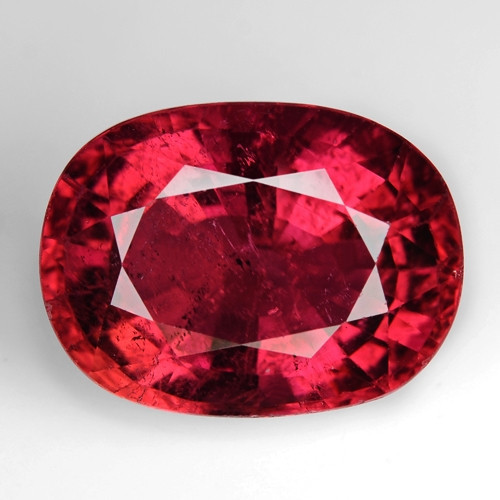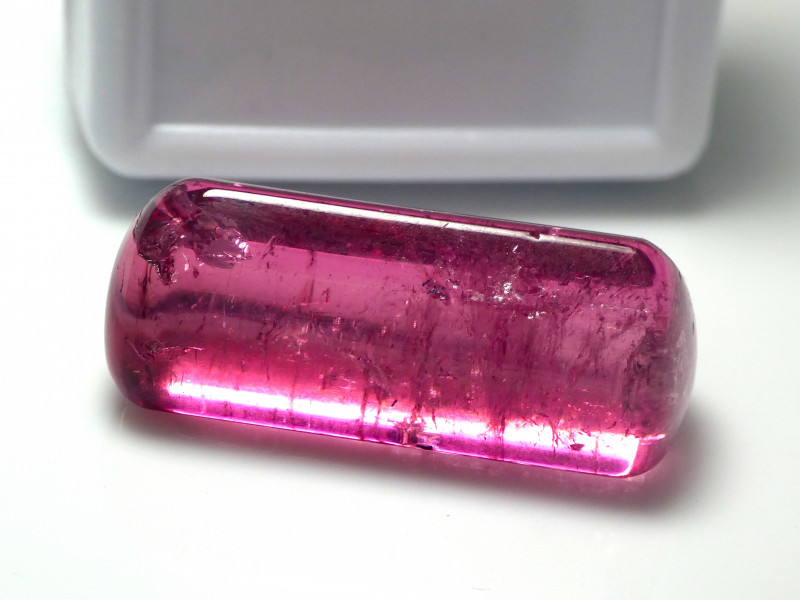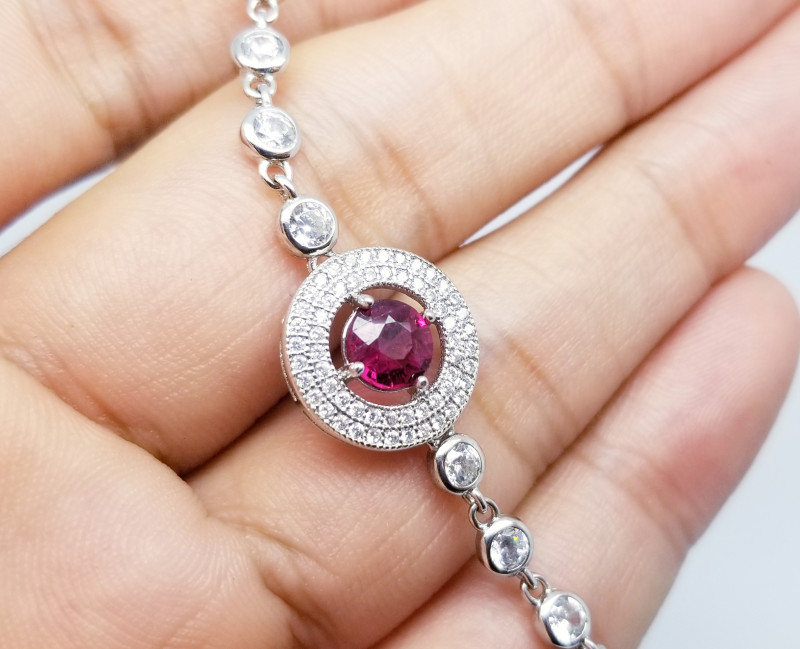
Tourmaline rubellite : signification, prix et avantages
 La rubellite est une variété de tourmaline rare et recherchée, aux teintes romantiques de rouge et de rose. Le cristal de tourmaline est souvent associé au rubis, bien qu'il s'agisse de pierres différentes.
La rubellite est une variété de tourmaline rare et recherchée, aux teintes romantiques de rouge et de rose. Le cristal de tourmaline est souvent associé au rubis, bien qu'il s'agisse de pierres différentes.
La tourmaline rose et la rubellite sont-elles identiques ? Les réponses diffèrent, mais la plupart des gens diraient que la « tourmaline rose » est un autre nom pour la rubellite. Cependant, certaines teintes roses rares apparaissent dans d'autres variétés de tourmaline.
Quoi qu'il en soit, la rubellite est connue pour ses teintes rouges. Mais saviez-vous que le rouge est la couleur la plus rare des pierres précieuses ? La rubellite, avec le rubis et le spinelle rouge, est la seule gemme à présenter une couleur rouge foncé aussi pure et luxuriante, ce qui ajoute à son charme.
Déjà séduit(e) ? Restez connectés pour en savoir plus sur les propriétés, la signification, les prix et bien plus encore de la tourmaline rubellite !

Qu'est-ce que la tourmaline rubellite ?
La rubellite est une pierre précieuse semi-précieuse , bien qu'elle partage des teintes et une étymologie similaires avec la pierre précieuse rubis .
En parlant de noms, la rubellite peut s'écrire rubélite ou rubylite. D'autres surnoms incluent apyrite, aphrite et schorl rouge, bien que schorl rouge soit plus souvent synonyme de rutile.
En tant que tourmaline, la rubellite est une pierre de naissance pour le mois d'octobre , une pierre du zodiaque Balance et une pierre précieuse pour le 8e anniversaire de mariage . La rubellite commémore spécifiquement le 5e anniversaire et est une pierre étoile du soleil.
La ressemblance du cristal avec le rubis en fait un substitut plus abordable au rubis, que ce soit comme pierre de naissance de juillet ou comme cadeau pour le 40e anniversaire de mariage.
À ce sujet, clarifions toute confusion entre le rubis et la rubellite.
 Sur la photo ci-dessus : Ruby
Sur la photo ci-dessus : Ruby
Rubellite contre rubis
La rubellite a toujours été confondue avec le rubis. Les deux pierres présentent des similitudes : des couleurs allant du rouge au rose, des noms qui reflètent ces couleurs et une grande facilité de port. Mais c'est à peu près tout pour les similitudes.
Contrairement à la tourmaline rubellite, le rubis est une pierre précieuse de type corindon . Bien que ces deux pierres soient anciennes, le rubis a joué un rôle plus important dans l'histoire.
En termes de prix, la rubellite est-elle plus chère que le rubis ? Non, c'est tout le contraire.
Leurs propriétés minérales diffèrent également. Les rubis se classent à 9 sur l' échelle de dureté minérale de Mohs , tandis que les rubellites se situent entre 7 et 7,5.
Les types d' inclusions des deux pierres sont suffisamment différents pour être identifiés. Alors que les rubis sont connus pour leurs inclusions « soyeuses » de rutile en forme d'aiguilles, les rubellites sont connues pour leurs inclusions fluides pouvant former des torsades ou des toiles filiformes appelées « trichites ».
En développant la minéralogie, nous approfondirons ensuite les caractéristiques minérales de la rubellite.
Spécifications et caractéristiques de la rubellite
La rubellite fait partie de la famille des tourmalines elbaïtes, un groupe de borosilicates de sodium, d'aluminium et de lithium. Les elbaïtes sont le groupe le plus coloré et contiennent le plus de variétés de qualité gemme. Parmi les autres tourmalines elbaïtes, on trouve l'indicolite , la tourmaline Paraïba et la tourmaline chromifère .
Parfois, certaines rubellites peuvent être classées comme liddicoatite – une série rare semblable à l'elbaïte, mais contenant du calcium au lieu du sodium – ou olénite – une série à forte teneur en aluminium qui forme une série avec la schorl (tourmaline noire) et l'elbaïte. Cependant, la majorité des rubellites sont des tourmalines elbaïtes.
Comme mentionné précédemment, certains gemmologues différencient la tourmaline rose de la rubellite. En général, la différence supposée entre la rubellite et la tourmaline rose réside dans une couleur beaucoup plus saturée.
De plus, certains prétendent également que la « rubellite » ne fait référence qu’aux tourmalines rouges qui conservent une couleur rouge sous différents types d’éclairage.
Vous trouverez ci-dessous les propriétés restantes de la rubellite :
Dureté Mohs : 7-7,5
Couleur : Nuances principalement saturées de rouge et de rose ; peut être violet-rouge, brun-rouge, orange-rouge
Structure cristalline : Hexagonale (trigonale)
Lustre : Vitreux (vitreux)
Transparence : Transparent à opaque
Indice de réfraction : 1,619-1,655
Densité : 3,01-3,06
Décolleté : Aucun
Fracture : Conchoïdale ou irrégulière
Série : Blanche
Luminescence : Fluorescence parfois présente mais faible - rouge à violet en SW-UV et LW-UV
Pléochroïsme : Présent en incolore à rose moyen/rose clair ou rouge rosé à rouge foncé
Biréfringence : 0,014-0,040
Dispersion : 0,017 (modérée)
Effets optiques : Parfois chatoiement, changement de couleur
Cela couvre la minéralogie, il est donc temps de vérifier la signification spirituelle de la rubellite.

Signification et histoire de la tourmaline rubellite
Toutes les tourmalines symbolisent la sagesse, le pardon et la guérison. Les rubellites représentent plus particulièrement l'amour, l'optimisme et l'amitié. On pense que ce cristal renforce les liens d'amitié, surtout lorsqu'il est offert en cadeau.
De plus, la rubellite symboliserait la passion, la vitalité et le courage. Les pierres roses évoquent le romantisme, la gentillesse et la féminité.
Histoire
Vous vous souvenez quand nous avons mentionné que la rubellite avait été historiquement confondue avec le rubis ? Certaines de ces rubellites ont même fini par figurer sur des bijoux royaux !
Par exemple, au XVIIe siècle, le tsar russe Pierre le Grand a commandé des bijoux en rubis pour la cour impériale, qui se sont avérés être de la rubellite.
Un autre exemple célèbre est le « rubis de César ». Les archives de cette pierre précieuse de 255,75 carats, en forme de framboise ou de grappe de raisin, remontent aux années 1500, lorsqu'elle appartenait au roi de France Charles IX . Peu après, la pierre fut donnée à l' empereur du Saint-Empire romain germanique Rodolphe II .
Vers 1650, la pierre précieuse parvint à Christine, reine de Suède , qui la mit en gage après son abdication. Après la mort de Christine, le roi de Suède Charles XI fit rapatrier les bijoux mis en gage et les fit placer parmi les joyaux de la Couronne.
Dans un étrange lien avec l'erreur de Pierre le Grand, le roi suédois Gustave III offrit à l'impératrice russe Catherine la Grande (sa cousine) le célèbre « rubis de César » en 1786. Cette pierre s'est retrouvée parmi les joyaux de la couronne russe, faisant officiellement partie des joyaux royaux de deux pays différents.
Le « rubis de César » a été officiellement confirmé comme étant de la rubellite en 1926. Mais même dans les années 1500, cette identité erronée était loin d'être nouvelle.
Depuis l'époque de la Grèce et de la Rome antiques, la rubellite était confondue avec le rubis, la tourmaline bleue avec le saphir et la tourmaline verte avec l'émeraude .
Vers le XIXe siècle, la tourmaline fut enfin identifiée comme une espèce minérale à part entière. La première mention connue du mot « rubellite » remonte à 1794. Le nom dérive du latin rubellus , qui signifie « rougeâtre ».
Outre le fait d'avoir semé la confusion au sein de la famille royale pendant des siècles, à quoi sert la rubellite ?

Propriétés curatives de la rubellite
Toutes les pierres précieuses, y compris la rubellite, peuvent être des pierres de guérison grâce à leur couleur et à leurs énergies. La rubellite rouge, comme toutes les pierres précieuses rouges , stimule naturellement la vitalité, la passion et la motivation.
La rubellite rose, comme d'autres pierres précieuses roses , favorise l'amour de soi, la compassion et la guérison émotionnelle. Les pierres roses et rouges, comme la rubellite, sont également d'excellentes pierres pour le chakra du cœur, équilibrant le centre énergétique et permettant de donner et de recevoir de l'amour en toute liberté.
Guérison physique
Certains avantages supposés de la tourmaline rubellite incluent l’aide à :
Problèmes cardiaques
circulation sanguine
Dépression
Coordination œil-main
Problèmes digestifs
On dit également que la rubellite améliore la clarté mentale en harmonisant les deux hémisphères du cerveau.
Guérison émotionnelle
Si vous avez l'impression que votre enthousiasme a cédé la place à l'apathie ou au doute, la rubellite peut vous aider. Ce cristal est réputé pour redonner énergie, passion et détermination.
De même, on pense que la rubellite aide ceux qui se remettent d’un deuil ou d’un chagrin d’amour à trouver la volonté de continuer à progresser.
En général, les guérisseurs de cristaux recommandent la rubellite pour une plus grande confiance en soi, du courage et de l'acceptation.

Propriétés de la pierre précieuse rubellite
La valeur de la rubellite dépend de sa couleur, de sa taille, de sa clarté, de son poids en carats et de ses traitements.
Couleur
Les rubellites peuvent être roses à rouges, avec des nuances violettes, orange ou brunes. Leur couleur provient d'impuretés de manganèse ou de fer, et les centres colorés par irradiation naturelle produisent parfois des teintes roses. La couleur vire souvent au pêche sous une lumière incandescente.
Certains gemmologues classent uniquement les tourmalines rouges à violet rougeâtre avec une saturation moyenne à foncée comme « vraie » rubellite.
Les pierres d'un rouge pur, sans nuances brunes et avec une faible variation de couleur, sont les plus précieuses. La différence de valeur entre une rubellite rouge pur et une rubellite rouge-violet dépend du classement en laboratoire.
Couper
Les rubellites sont généralement facettées , et les tailles personnalisées augmentent leur valeur. Les spécimens fortement inclus peuvent être sculptés ou taillés en cabochon . Les spécimens chatoyants doivent être taillés en cabochon pour mettre en valeur leur « œil de chat ».
Bien que les rubellites existent sous toutes les formes facettées, une pierre brute de couleur foncée peut limiter les possibilités. Une taille de haute qualité peut augmenter la valeur de la pierre.
Clarté
La rubellite possède une pureté de type III, ce qui la rend encore plus rare sans inclusions visibles. Ces spécimens rares, parfaitement purs à l'œil nu, ont une valeur exceptionnelle.
Récemment, des rubellites d'une clarté supérieure ont été découvertes dans des régions africaines, mais les spécimens ont une coloration inférieure à la moyenne.
Les inclusions courantes dans la rubellite comprennent :
Fractures longues, fines et remplies de gaz qui réfléchissent la lumière
Tubes creux
aiguilles
Zonage des couleurs
Torsades ou toiles filiformes liquides ou gazeuses
Le dernier de la liste ci-dessus forme les « trichites » évoqués précédemment.
Les inclusions étant très fréquentes dans la rubellite, leur valeur ne diminue pas trop, sauf si elles sont suffisamment abondantes pour provoquer une turbidité. Certaines inclusions, notamment les tubes fins et creux, peuvent également provoquer une chatoyance.
Poids et taille en carats
Heureusement, il existe une rubellite, disponible dans des tailles adaptées à tous les budgets et à tous les styles. Les pierres de 1 à 6 carats sont les plus courantes, tandis que celles de plus de 15 carats sont plus rares. Cependant, les rubellites facettées, présentant une belle couleur et une belle clarté, sont plus rares au-delà de 2 carats environ.
En 2011, le plus gros cabochon œil-de-chat en rubellite pesait 295,08 carats, selon le Livre Guinness des records. Le plus gros cristal unique, découvert au Brésil, pesait 374 000 carats.
Traitements et simulants
Les traitements thermiques et radiologiques sont courants pour les rubellites. Souvent, les bijoutiers chauffent une pierre pour la rendre incolore, puis l'irradient pour lui donner une couleur rouge rubis. Parfois, la rubellite rose pâle est irradiée pour obtenir cette couleur rouge rubis.
Ces traitements sont stables et ne diminuent généralement pas beaucoup la valeur, mais ils doivent être divulgués.
Certaines rubellites peuvent subir des traitements de fracture ou de remplissage de cavités pour augmenter la durabilité et améliorer la clarté.
Deux indications d'une rubellite traitée incluent une coloration identique sur plusieurs rubellites - rare dans les pierres précieuses non traitées - et aucun changement de couleur.
En ce qui concerne les simulants , le quartz teinté ou le spinelle synthétique sont parfois vendus sous le nom de rubellite.

Formation et sources de rubellite
La rubellite se forme, comme toutes les tourmalines, en cristallisant à partir d'eaux souterraines contenant des éléments dissous qui se déposent dans les vides des roches ignées, puis s'évaporent. Les mineurs trouvent généralement des rubellites dans les pegmatites.
La roche autour de la rubellite peut également s'éroder, permettant aux cristaux de rubellite de se briser et de se déplacer dans les dépôts alluviaux.
Emplacements miniers
D'où vient la tourmaline rubellite ? Les principales régions où l'on trouve de la rubellite de qualité gemme sont :
Afghanistan
Argentine
Autriche
Brésil
Italie
Madagascar
Mozambique
Birmanie
Nigeria
Russie
États-Unis (Maine)
Maintenant, combien vaut la rubellite ?

Prix et valeur de la rubellite
Bien que rare et populaire, la rubellite a une gamme de prix plus large pour différents budgets que les autres tourmalines coûteuses.
Les prix de la tourmaline rubellite pour les gemmes rouges facettées de bonne qualité :
0,5 à 1 carat : 30 à 250 $ par carat
1 à 5 carats : 40 à 500 $ par carat
5+ carats : 40 $ à 650 $ par carat
Les prix par carat des pierres précieuses de rubellite rose facettées de bonne qualité varient désormais :
0,5 à 1 carat : 30 à 150 $ par carat
1 à 5 carats : 60 à 600 $ par carat
5+ carats : 60 $ à 550 $ par carat
Ensuite, les gammes de prix des cabochons de rubellite œil de chat :
0,5 à 1 carat : 35 $ à 100 $ par carat
1 à 5 carats : 35 $ à 200 $ par carat
5+ carats : 35 $ à 400 $ par carat
Les meilleures pierres précieuses de rubellite à facettes peuvent atteindre 1 000 $ par carat.
Les cristaux de tourmaline rubellite bruts à facettes coûtent entre 10 et 30 $ par carat en gros.
Enfin, nous discuterons de l’entretien des pierres précieuses .
Entretien et maintenance de la rubellite
La rubellite est suffisamment résistante pour être portée au quotidien. Cependant, une bague en tourmaline rubellite plus fragile pourrait être protégée par des montures protectrices , surtout si vous la portez régulièrement (comme une bague de fiançailles).
Cela dit, les rubellites avec des traitements de comblement ou de nombreuses inclusions sont plus fragiles. Ces pierres sont sensibles à la chaleur et plus sujettes à la casse ; évitez donc les systèmes de nettoyage mécaniques (par exemple, ultrasons ou vapeur).
Les rubellites traitées thermiquement et/ou par irradiation ne sont pas fragiles comme celles qui ont été huilées, remplies ou teintes.
Dans l’ensemble, gardez votre rubellite loin de :
Chaleur intense (y compris le stockage en plein soleil)
Changements soudains de température
Produits chimiques agressifs
Nettoyez la rubellite avec une brosse à dents souple, de l'eau tiède et du savon doux. Rangez-la à l'écart des autres pierres précieuses.

Prêt à rayonner avec la Rubellite ?
Parmi toutes les tourmalines, la rubellite est la deuxième en valeur et en popularité, juste après la tourmaline Paraïba. Cette pierre écarlate a gagné sa place parmi les pierres précieuses les plus prestigieuses, aux côtés de son « jumeau » erroné, le rubis.
Oubliez les pantoufles en rubis et suivez votre route de briques jaunes avec de superbes bijoux en rubellite !
Rechercher le Gemstone Encyclopedia
Enchères associées
Articles Liés
Il existe des dizaines de quartz et de calcédoine aux couleurs et motifs variés. Découvrez les propriétés du quartz et tous ses types, de l'améthyste et l'agate au quartz plasma et au quartz fantôme !
15th Oct 2020
Laissez-nous vous expliquer comment acheter des pierres précieuses sur Internet. Nous proposons la plus grande sélection de pierres précieuses sur Internet, et cela peut être un peu compliqué au début. Laissez-nous vous guider avec quelques conseils utiles.
3rd Oct 2018
L'améthyste est un quartz aux nuances variées d'un violet éclatant. Découvrez son histoire, ses propriétés, sa valeur et ses utilisations dans ce guide informatif !
5th May 2021
Derniers articles
Les sculptures en ivoire de palmier, aussi appelé ivoire végétal, sont une alternative naturelle à l'ivoire d'éléphant. Elles sont obtenues de manière éthique à partir de la noix du palmier Phytelephas d'Amérique du Sud. Découvrez tout sur l'ivoire de palmier dans ce guide !
15th Jan 2026
Les pierres en forme de chrysanthème sont des merveilles naturelles présentant un motif floral en calcite blanche, en célestine ou en andalousite sur fond de calcaire ou de mudstone noir.
13th Jan 2026
La pierre de soleil à treillis arc-en-ciel est une variété de feldspath présentant trois magnifiques effets optiques dus à la présence de diverses inclusions. Son éclat irisé et ses motifs en treillis en font une gemme rare et recherchée par les collectionneurs !
12th Jan 2026
Catégories d'articles
How To's is where you will find helpful articles from gem Rock Auctions on how to cut gemstones, select gemstones and buy gemstones.
9 les articles





